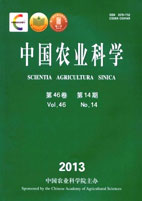-
Research on Soil and Leaf Nutrient Diagnosis of ‘Red Fuji’ Apple Orchard in Two-Dominant Producing Areas
- WANG Fu-Lin, MEN Yong-Ge, GE Shun-Feng, CHEN Ru, DING Ning, PENG Fu-Tian, WEI Shao-Chong, JIANG Yuan-Mao
-
Scientia Agricultura Sinica. 2013, 46(14):
2970-2978.
doi:10.3864/j.issn.0578-1752.2013.14.013
-
 Abstract
(
808 )
Abstract
(
808 )
 PDF (811KB)
(
747
)
PDF (811KB)
(
747
)
 Save
Save
-
References |
Related Articles |
Metrics
【Objective】Soil available nutrients and leaf mineral elements and nutritional status in ‘Red Fuji’ apple orchards in two dominant producing areas of Circum-Bohai and Loess Plateau in China were determined in order to conduct the analysis and diagnosis for ‘Red Fuji’ apple orchard nutritional status for guiding scientific fertilization.【Method】Based on soil available nutrient classification standards and DRIS nutrient diagnosis, soil and leaf samples from high and low yield orchards of 15-20-year old trees of two apple producting areas were analyzed. Differences among treatments were separated by the least significant difference (LSD) test, and One-Way Anova and difference analysis were conducted by DPS V7.05.【Result】The organic matter, alkaline hydrolysis N, available P, available K of soil available nutrient content average values were 10.9 g•kg-1, 73.21 mg•kg-1, 70.22 mg•kg-1, and 169.2 mg•kg-1 in Circum-Bohai, respectively, while the soil available nutrient content average values were 11.7g•kg-1, 56.46 mg•kg-1, 14.91 mg.kg-1, and 135.78 mg•kg-1 in Loess Plateau, respectively. The alkaline hydrolysis N, available P, available K in Circum-Bohai were higher than those in Loess Plateau, except organic matter. The N, P, K, Ca, Mg, Fe, Mn, Cu, Zn, B, Mo content of average values were 2.73%, 0.18%, 1.15%, 9.63 g•kg-1, 2.86 g•kg-1, 87.97 mg•kg-1, 124.02 mg•kg-1, 13.36 mg•kg-1, 15.64 mg•kg-1, 35.09 mg•kg-1, and 0.51 mg•kg-1 in Circum-Bohai, respectively. The leaf average values were 2.72%, 0.18%, 1.17%, 10.23 g•kg-1, 2.99 g•kg-1, 88.69 mg•kg-1, 116.39 mg•kg-1, 10.85 mg•kg-1, 15.94 mg•kg-1, 39.55 mg•kg-1, and 0.51 mg•kg-1 in Loess Plateau, respectively. The DRIS diagnostic results in two-dominant producing areas indicated that the most deficient leaves elements were Ca and K in low-yielding orchard of Circum-Bohai, followed by Fe, N, and Zn, and the most wealthy elements were Cu and Mo. The most lacking elements were P and K in Loess Plateau, followed by N, Zn, and Cu, and the most wealthy elements were B and Ca.【Conclusion】It was concluded that the organic contents in two regions were slightly low, the soils are deficient in N. P is rich and K is deficient in soils in Circum-Bohai region, while P is poor and K is deficient in soils in Loess Plateau. Leaf diagnosis of low-yield orchards showed that the nutrition at status of trees in Loess Plateau was better than that of the Circum-Bohai , and both areas had a great potential of production. It was suggested that fertilizer of K, N, Fe, Ca, and Zn in Circum-Bohai should be increased, and fertilizers of K, P, Zn, Cu, and Fe should be increased in Loess Plateau, meanwhile organic manure should be attached to the along with chemical fertilizer.









